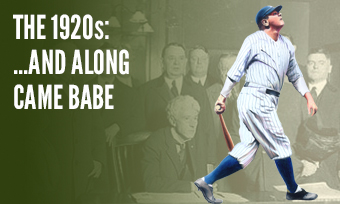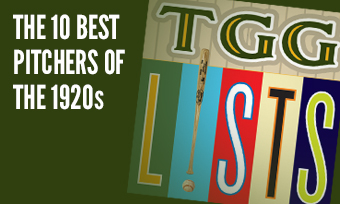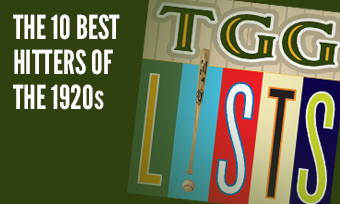The Yearly Reader
Leaders and Honors, 1920
Our list of baseball’s top 10 hitters and pitchers in both the American League and National League for the 1920 baseball season, as well as the awards and honors given to the game’s top achievers of the year.
The National League’s Top 10 Hitters, 1920
Bold type in brick red indicates league leader.
1. Rogers Hornsby, St. Louis
Key Numbers: .370 average, 96 runs, 218 hits, 44 doubles, 20 triples, 9 home runs, 94 RBIs, .431 on-base percentage, .559 slugging percentage.
The Rajah shifted into superstar mode and won his first of six straight batting titles.
2. Ross Youngs, New York
Key Numbers: .351 average, 92 runs, 204 hits, 27 doubles, 14 triples, 6 home runs, 78 RBIs, 75 walks.
At age 23, the Shiner, Texas native shined as he cut into a star groove, finishing second behind Hornsby in the NL batting race.
3. Edd Roush, Cincinnati
Key Numbers: .339 average, 196 hits, 16 triples, 90 RBIs, 36 stolen bases.
Typically gruff when awakened to start a season, perhaps the most refreshing aspect of Roush’s campaign for the Reds, beyond the numbers, was that he actually reported to Spring Training on time.
4. Cy Williams, Philadelphia
Key Numbers: .325 average, 192 runs, 36 doubles, 10 triples, 15 home runs, 72 RBIs.
Aided by 12 home runs hit at Baker Bowl alone, Williams would try and become the NL’s answer to Babe Ruth—though his 15 total clouts wouldn’t even represent a third of Ruth’s total.
5. Zack Wheat, Brooklyn
Key Numbers: .328 average, 89 runs, 191 hits, 13 triples, 9 home runs, 73 RBIs.
Wheat warmed up with the weather, hitting .371 over his final 97 games after struggling with a .258 mark through the first 51.
6. Hi Myers, Brooklyn
Key Numbers: .304 average, 83 runs, 177 hits, 36 doubles, 22 triples, 80 RBIs.
For the second straight year, Myers led the NL in triples; his 22 still remains the Dodgers’ modern (post-1900) record.
7. Irish Meusel, Philadelphia
Key Numbers: .309 average, 27 doubles, 8 triples, 14 home runs, 69 RBIs.
Like Cy Williams above, Meusel’s home run total was lifted thanks to Baker Bowl; 12 of his 14 were hit at the Phillies’ ballyard.
8. George Burns, New York
Key Numbers: .287 average, 115 runs, 181 hits, 35 doubles, 9 triples, 6 home runs, 76 walks, 22 stolen bases.
At age 30, Burns’ speed began to elude him—he stole 22 bags after nabbing 40 in each of his previous three years—but it didn’t keep him from leading the NL in runs for the fifth and last time.
9. Dave Robertson, Chicago
Key Numbers: .300 average, 29 doubles, 11 triples,10 home runs, 75 RBIs.
In his one full season at Chicago, Robertson returned to form after the Great War interrupted his career.
10. Jack Fournier, St. Louis
Key Numbers: .306 average, 33 doubles, 14 triples, 12 hit-by-pitches, 26 stolen bases.
Rogers Hornsby got support in the lineup from Fournier, all but missing in action from the majors over the previous three years because of his suspect defense.
The American League’s Top 10 Hitters, 1920
1. Babe Ruth, Boston
Key Numbers: .376 average, 158 runs, 172 hits, 36 doubles, 9 triples, 54 home runs, 135 RBIs, 150 walks, .532 on-base percentage, .847 slugging percentage.
Ruth in 1920 was, as George Will would later say, like Mt. Everest in Kansas.
2. George Sisler, St. Louis
Key Numbers: 154 games, .407 average, 631 at-bats, 137 runs, 257 hits, 49 doubles, 18 triples, 19 home runs, 122 RBIs, 42 stolen bases.
Astonishingly, Sisler collected more total bases (399) than Ruth (388). He also racked up a remarkable 41 games with three or more hits, good for an all-time major league record.
3. Tris Speaker, Cleveland
Key Numbers: .388 average, 137 runs, 214 hits, 50 doubles, 11 triples, 8 home runs, 107 RBIs, 97 walks.
Like Sisler with the Browns, Speaker was a primary reason the Indians became one of the first two teams (along with the Browns) to hit over .300 in the 20th century.
4. Joe Jackson, Chicago
Key Numbers: .382 average, 105 runs, 218 hits, 42 doubles, 20 triples, 12 home runs, 121 RBIs.
Shoeless Joe appeared to ramp up with the advent of the live-ball era; because of the Black Sox Scandal, we’ll never know how much better he would have been.
5. Eddie Collins, Chicago
Key Numbers: .372 average, 117 runs, 224 hits, 38 doubles, 13 triples, 76 RBIs, 69 walks.
Not part of the Black Sox’ game-fixing cabal, Collins’ career would roll on; his .372 average in 1920 would be a personal best.
6. Happy Felsch, Chicago
Key Numbers: .338 average, 188 hits, 40 doubles, 15 triples, 14 home runs, 115 RBIs.
Like Joe Jackson above, Felsch would also rob himself of a furtive baseball future—but unlike Jackson, he still had the bulk of his career to show off.
7. Baby Doll Jacobson, St. Louis
Key Numbers: 154 games, .355 average, 97 runs, 216 hits, 34 doubles, 14 triples, 9 home runs, 122 RBIs.
The end of the Deadball Era certainly suited Jacobson, who had been lucky to hit over .250 before the ball came to life.
8. Elmer Smith, Cleveland
Key Numbers: .316 average, 37 doubles, 10 triples, 12 home runs, 103 RBIs.
In the best year of an otherwise common career, Smith hit two grand slams in the season to go along with the one belted in the World Series—the first ever in Fall Classic competition.
9. Sam Rice, Washington
Key Numbers: .338 average, 211 hits, 29 doubles, 9 triples, 80 RBIs, 63 stolen bases.
Rice would set a Senators record by hitting safely in 29 consecutive games; he would reset the mark to 31 games in 1924. (Heinie Manush would top that with 33 in 1933, and that remains the franchise high.)
10. Bobby Veach, Detroit
Key Numbers: 154 games, .307 average, 92 runs, 188 hits, 39 doubles, 15 triples, 11 home runs, 113 RBIs.
With Ty Cobb “slumping” to a .334 average due to a knee injury, Veach briefly took over as the biggest everyday threat in the Tigers’ lineup.
The National League’s Top 10 Pitchers, 1920
1. Pete Alexander, Chicago
Key Numbers: 1.91 ERA, 27 wins, 14 losses, 40 starts, 33 complete games, 363.1 innings, 173 strikeouts.
Pitching like the pre-war workhorse, Alexander won his first 11 games while racking up an unprecedented sixth straight sub-2.00 ERA campaign.
2. Wilbur Cooper, Pittsburgh
Key Numbers: 2.39 ERA, 24 wins, 15 losses, 37 starts, 327 innings.
The Pirates’ all-time leader in wins, Cooper reached a career pinnacle with 24.
3. Burleigh Grimes, Brooklyn
Key Numbers: 2.22 ERA, 23 wins, 11 losses, .676 win percentage, 303.2 innings.
How grand (fathered) it is to be exempted from the spitball ban; after successfully lobbying for baseball to allow established spitballers to keep throwing the wet stuff, Grimes slobbered his way to a spot among the game’s pitching elite.
4. Babe Adams, Pittsburgh
Key Numbers: 2.16 ERA, 17 wins, 13 losses, 8 shutouts, 263 innings, 18 walks.
The vintage stage of Adams’ career hit a peak by walking just 0.61 batters per nine innings—a modern record which would hold until Carlos Silva beat it in 2005.
5. Art Nehf, New York
Key Numbers: 3.08 ERA, 21 wins, 12 losses, 280.2 innings.
The third of the Giants’ 20-game winners, the southpaw reached the milestone for the first time and first of two consecutive seasons.
6. Jesse Barnes, New York
Key Numbers: 2.64 ERA, 20 wins, 15 losses, 292.2 innings.
Barnes was one of three Giants hurlers to win 20 games—and barely, earning his 20th with four innings of hitless relief in his final appearance of the season.
7. Dolf Luque, Cincinnati
Key Numbers: 2.51 ERA, 13 wins, 9 losses.
After continuing to bounce back-and-forth between the rotation and bullpen to begin the season, the Cuban native finally found a foothold as a starter that would make him a mainstay for the Reds throughout the 1920s.
8. Fred Toney, New York
Key Numbers: 2.65 ERA, 21 wins, 11 losses, 37 starts, 278.1 innings.
The veteran right-hander finished strong—but only after he chewed out (and nearly beat up) Giants catcher Frank Synder when the latter dared to criticize him.
9. Dutch Ruether, Cincinnati
Key Numbers: 2.47 ERA, 16 wins, 12 losses, 37 appearances, 23 complete games, 265.2 innings, 10 stolen bases allowed, 28 caught stealing.
A great start for Ruether as he racked up the wins and looked locked in on an ERA crown—but he collapsed over the final two months, failing to win any of his last 10 starts with a 4.78 ERA.
10. Bill Doak, St. Louis
Key Numbers: 2.53 ERA, 20 wins, 12 losses, 39 appearances, 270 innings, 26 grounded into double plays.
Few Cardinals were happier with the team’s midseason move from rotting Robison Field to Sportsman’s Park, where Doak went 7-1 with a 1.37 ERA over 11 starts—on the way to his only 20-win season.
The American League’s Top 10 Pitchers, 1920
1. Stan Coveleski, Cleveland
Key Numbers: 2.49 ERA, 24 wins, 14 losses, 315 innings, 133 strikeouts.
Though his won-loss record paled in comparison to Jim Bagby (#2 below), Coveleski proved tougher on opposing batters—and also got a bit less run support (5.0 per starts to Bagby’s 6.3).
2. Jim Bagby, Cleveland
Key Numbers: 2.89 ERA, 31 wins, 12 losses, .721 win percentage, 48 appearances, 39 starts, 30 complete games, 339.2 innings.
A record 17 pitchers won 20 games in 1920, and rising above them all was Bagby—one of 13 hurlers since 1900 to win 30.
3. Urban Shocker, St. Louis
Key Numbers: 2.71 ERA, 20 wins, 10 losses, 5 saves, 245.2 innings.
Shocker was a rarity for the 1920s: A good player stolen from, not by, the Yankees. They’d eventually get him back anyway.
4. Bob Shawkey, New York
Key Numbers: 2.45 ERA, 20 wins, 13 losses, 267.2 innings.
Shawkey won 11 straight games early on and posted the highest ERA by a league leader since 1899.
5. Red Faber, Chicago
Key Numbers: 2.99 ERA, 23 wins, 13 losses, 39 starts, 319 innings.
One of four White Sox pitchers to win at least 20 games—a major league first—Faber’s 2.99 ERA was the lowest among the quartet.
6. Eddie Cicotte, Chicago
Key Numbers: 3.26 ERA, 21 wins, 10 losses, 303.1 innings.
Before being ruined by scandal, Cicotte would see his success muted by the abolishment of the shineball he thrived on.
7. Carl Mays, New York
Key Numbers: 3.06 ERA, 26 wins, 11 losses, 6 shutouts, 312 innings.
The irascible—and vilified, after one of his pitches killed the Indians’ Ray Chapman—Mays showed no slacking off after the tragedy, going 7-2 with a 2.07 ERA.
8. Dickie Kerr, Chicago
Key Numbers: 3.37 ERA, 21 wins, 9 losses, 5 saves, 253.2 innings.
One of the “clean” Sox, Kerr completed his lone 20-win campaign and led the AL in saves in what would be his second of only three full seasons at the big-league level.
9. Eddie Rommel, Philadelphia
Key Numbers: 2.85 ERA, 7 wins, 7 losses, 34 appearances, 12 starts.
One of the game’s first knuckleballers, the 22-year-old rookie was fortunate enough to garner a .500 record on a team that finished 48-106.
10. Jack Quinn, New York
Key Numbers: 3.20 ERA, 18 wins, 10 losses, 253.1 innings.
Being grandfathered as an exempted spitballer helped Quinn become one of the AL’s more efficient pitchers—and allowed him to pitch until he was nearly 50.









